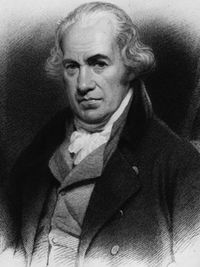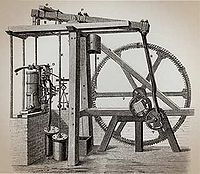James Watt

James Watt (1736-1819) was an inventor, mechanical engineer, and chemist best known for his improvements to the steam engine, which spurred the Industrial Revolution in Europe and the United States, as well as for his creation of the term "horsepower." The SI unit for power, the Watt, is named after James Watt in recognition of his contributions to the concept of power and how it is used today.
Personal Life
Early Life
Watt's father owned a prosperous shipbuilding business in Scotland. As a young teen, Watt worked with a wide variety of instruments and knew that he wanted to become an instrument maker (in modern terms, an engineer). After a large portion of his father's investments failed, Watt traveled to London to apprentice with a renowned instrument maker, John Morgan. After completing his apprenticeship, Watt was offered work at the University of Glasgow.
Career and Later Life
In 1763, Watt was given the task of repairing a malfunctioning steam engine by a professor at the University of Glasgow. While Watt found the flaw in the model engine, he realized that the most modern design, the Newcomen engine, which had remained largely unchanged for nearly 50 years, was hopelessly inefficient due to massive amounts of energy wasted. The current design, he demonstrated, converted nearly three-quarters of its energy to thermal energy, rather than mechanical energy.
Watt spent two years creating a new design and several more improving on the Newcomen steam engine, eventually acquiring a patent in 1769. Capital from John Roebuck and Matthew Boulton finally led to the manufacture of Watt's steam engine in 1776, 11 years after he first created his new design. In 1781, Watt made his next landmark improvement to the steam engine, creating an engine with a rotary output through the invention of the planetary gear. Other improvements, like the throttling valve and the engine governor, finally allowed steam engines, previously confined to mining, to be used to supply power to manufacturing industries as well as to canals and waterworks. By his retirement in 1800, Bolton and Watt had became the most important engineering firm in the country.
Industrial Contributions

Watt's major contributions to steam engine development are as follows:
- Separate Condenser - This is what separates the Watt and Newcomen engines. Both steam engines rely on the changing of pressure, where the steam would be heated to expand it, and later cooled to condense it. In a Newcomen engine, this steam cylinder would be heated and cooled constantly, wasting energy to reheat the steel in the cylinder. The Watt engine solved this by creating a separate condenser, which could be cool while the steam cylinder could be hot, eliminating Newcomen's issues with heating.
- Sun and Planetary Gear - This gear system works by having a non-rotating planetary gear travel around a rotating sun gear. This allowed the conversion of parallel, "up-and-down" motion to rotary motion, and gave the steam engine many more practical uses.
- Steam Throttling Valve - This regulated steam flow from the boiler into the cylinder.
- Engine Governor (and connector to the throttling valve) - This allowed the steam engine to run at a constant engine speed.
- Double-Acting Cylinders - Watt invented a mechanism to match the rocking motion created by the engine with the linear motion of the piston, allowing for a "double-acting" cylinder. These cylinders had valves on both sides of the piston, allowing for the engine to do work on both the upward and downward strokes, rather than on solely the upward stroke.
- Steam Locomotive - Though never built, Watt applied for the first steam locomotive patent, in 1784.
Scientific Contributions
In addition to his inventions, Watt had numerous scientific contributions. They include:
- Introduction of the term horsepower to describe power output. He described one horsepower to be 33,000 ft*lbs/min. The horsepower is still in use as a unit today, often used to describe modern engines used in transportation vehicles. One horsepower is now defined to be about 735 Watts.
- First to explicitly suggest that water was composed of hydrogen and oxygen, in 1783. Previously, many had thought water to be its own element. Other scientists found hydrogen and oxygen could be created from water; Watt was the first to actually propose that water was made of hydrogen and oxygen.
- Independently proved the existence of latent heat, previously discovered by Joseph Black in 1750. Latent heat is the energy absorbed or released during a change in state, where the substance remains at the same temperature.
Interesting Facts
- Watt also created the world's first copying machine, similar to a photocopier, in order to help him copy his designs.
- Was close friends with Adam Smith, founder of Economics and writer of The Wealth of Nations, as well as with Joseph Black, who discovered latent heat and the element magnesium.
- Did lots of surveying work, and invented the micrometer, predecessor to the modern "rangefinder", in 1770-1771 to assist him in his surveying.
- Invented the flexible water main, first used in Glasgow, which is now common across the world in water delivery and sewage.
- Member of the Royal Society of Edinburgh, the Royal Society of London, and a Foreign Associate of the French Academy of Sciences.
See also
Further Reading
Carnegie, Andrew. James Watt (1913)
Dickinson, H. W., Jenkins, Rhys. James Watt and the Steam Engine (1919)
Marshall, Thomas. James Watt (1925)
External Links
http://www.bbc.co.uk/history/historic_figures/watt_james.shtml
http://www.sciencemuseum.org.uk/watt
http://digital.nls.uk/scientists/biographies/james-watt/
http://www.engineeringhalloffame.org/profile-watt.html
References
http://www.egr.msu.edu/~lira/supp/steam/wattbio.html (Michigan State University)
http://www.egr.msu.edu/~lira/supp/steam/ (Michigan State University)
http://www.britannica.com/biography/James-Watt (Encyclopedia Brittanica)
https://www.asme.org/engineering-topics/articles/energy/james-watt (American Society of Mechanical Engineers)
http://www.theguardian.com/technology/2015/may/29/james-watt-sabbath-day-fossil-fuel-revolution-condenser (The Guardian)
http://www.rsc.org/chemistryworld/podcast/CIIEcompounds/transcripts/water.asp (Royal Society of Chemistry)
http://www.famousscientists.org/james-watt/ (Famous Scientists)
Author: Joseph Clark (jclark302)